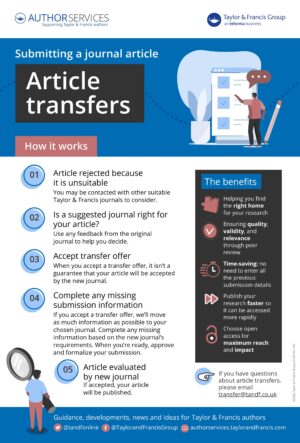Article transfers
How transferring can save you time and help you find the right journal for your paper
Having an article rejected by a journal happens to almost all academics during their career. There are many reasons why an article might be rejected but often this won’t be a judgement on the quality of your work. It might simply be because your manuscript is out of scope for the journal you’ve submitted to. In these circumstances the publisher may invite you to redirect your article to an alternative journal via a transfer process.
We’re currently expanding our transfer service across more journals to give authors a wider range of options from Taylor & Francis journals and platforms.
On this page, find out:
What are article transfers?
The benefits of article transfers
How does the process work?
Answers to common questions

Publishing tips, direct to your inbox
Expert tips and guidance on getting published and maximizing the impact of your research. Register now for weekly insights direct to your inbox.
What are article transfers?
The transfer, or ‘cascade’, process is designed for papers which editors judge to be unsuitable for the journal they were originally submitted to.
If your article falls into this category then one or more alternative journals from the same publisher may be suggested.
You will have the option to submit to one of those suggested journals for consideration. Or, you can decide to submit your article elsewhere.
What are the benefits of using a transfer service?
Helps you find the right home for your research.
You won’t need to enter all the details into a new submission system, so research is published faster and can be accessed more rapidly.
All articles transferred will be evaluated by the journal receiving the paper via the transfer service, ensuring an article’s quality, validity, and relevance.

How does the article transfer process work?
If your article is eligible for a transfer, you’ll receive an email introducing one or more related journals which may be suitable. Take time to investigate these journals and use any feedback the original journal gave you to decide whether one of the suggestions might be right for your article.
If you decide to accept a transfer offer, the publisher will move as much information as possible about your article over to the submission system of your chosen journal. You will have the opportunity to upload a revised version of your paper before submitting it for consideration by the editor.

The offer of an article transfer is not a guarantee that your article will be accepted by the new journal. Your article will be evaluated by the journal receiving the submission, ensuring quality, validity, and relevance.
F1000Research
For articles in relevant subject areas, you may also see F1000Research as an alternative recommendation.

This is a new part of the Taylor & Francis Group which offers an innovative route to publishing your work. Articles submitted to F1000Research are published rapidly as soon as they are accepted, after passing a series of pre-publication checks. Peer review by invited experts, suggested by the authors, takes place openly after publication. F1000Research operates an open data policy, requiring authors to cite repositories hosting the supporting data. An article remains published regardless of the reviewers’ reports.

Questions about the transfer scheme?
Visit our article transfer FAQs.
If you have any further questions, please contact: [email protected]
